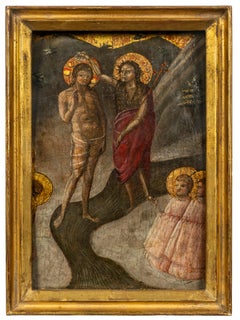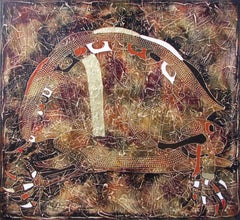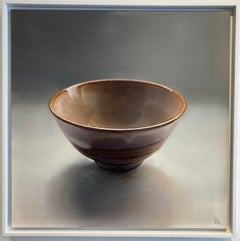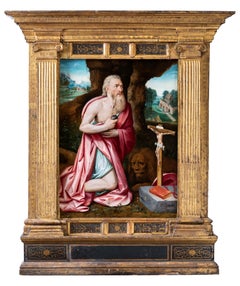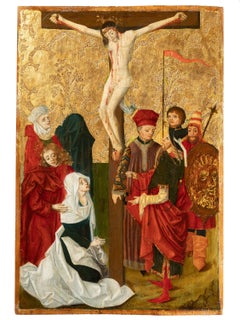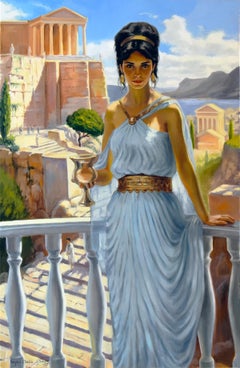15th Century and Earlier Figurative Paintings
to
7
5
6
9
3
1
7
3
2
1
Overall Height
to
Overall Width
to
6
1
11
8
4
3
2
2
2
2
2
1
1
1
1
1
1
1
1
932
2,228
12,021
29,040
265
269
533
727
581
783
839
900
1,039
968
432
10
9
5
4
3
Period: 15th Century and Earlier
The Resurrection of Christ
Located in New York, NY
Provenance:
with “Mr. Scheer,” Vienna, by July 1918; where acquired by:
Jindřich Waldes, Prague, 1918–1941; thence by descent to:
Private Collection, New York
Literature:
Rudolf Kuchynka, “České obrazy tabulové ve Waldesově obrazárně,” Památky archeologické, vol. 31 (1919), pp. 62-64, fig. 5.
Jaroslav Pešina, “K datování deskových obrazů ve Waldesově obrazárně,” Ročenka Kruhu pro Pěstování Dějin Umění: za rok (1934), pp. 131-137.
Jaroslav Pešina, Pozdně gotické deskové malířství v Čechách, Prague, 1940, pp. 150-151, 220.
Patrik Šimon, Jindřich Waldes: sběratel umění, Prague, 2001, pp. 166, 168, footnote 190.
Ivo Hlobil, “Tři gotické obrazy ze sbírky Jindřicha Waldese,” Umění, vol. 52, no. 4 (2004), p. 369.
Executed sometime in the 1380s or 1390s by a close associate of the Master of the
Třeboň Altarpiece, this impressive panel is a rare work created at the royal court in Prague and a significant re-discovery for the corpus of early Bohemian painting. It has emerged from an American collection, descendants of the celebrated Czech industrialist and collector Jindřich Waldes, who died in Havana fleeing Nazi-occupied Europe.
The distinctive visual tradition of the Bohemian school first began to take shape in the middle of the fourteenth century after Charles IV—King of Bohemia and later Holy Roman Emperor—established Prague as a major artistic center. The influx of foreign artists and the importation of significant works of art from across Europe had a profound influence on the development of a local pictorial style. Early Italian paintings, especially those by Sienese painters and Tommaso da Modena (who worked at Charles IV’s court), had a considerable impact on the first generation of Bohemian painters. Although this influence is still felt in the brilliant gold ground and the delicate tooling of the present work, the author of this painting appears to be responding more to the paintings of his predecessors in Prague than to foreign influences.
This Resurrection of Christ employs a compositional format that was popular throughout the late medieval period but was particularly pervasive in Bohemian painting. Christ is shown sitting atop a pink marble sarcophagus, stepping down onto the ground with one bare foot. He blesses the viewer with his right hand, while in his left he holds a triumphal cross with a fluttering banner, symbolizing his victory over death. Several Roman soldiers doze at the base of the tomb, except for one grotesque figure, who, beginning to wake, shields his eyes from the light and looks on with a face of bewilderment as Christ emerges from his tomb. Christ is wrapped in a striking red robe with a blue interior lining, the colors of which vary subtly in the changing light. He stands out prominently against the gold backdrop, which is interrupted only by the abstractly rendered landscape and trees on either side of him.
The soldiers’ armor is rendered in exacting detail, the cool gray of the metal contrasting with the earth tones of the outer garments. The sleeping soldier set within a jumble of armor with neither face nor hands exposed, is covered with what appears to be a shield emblazoned with two flies on a white field, somewhat resembling a cartouche (Fig. 1). This may be a heraldic device of the altarpiece’s patron or it may signify evil, referencing either the Roman soldiers or death, over both of which Christ triumphs.
This painting formed part of the collection assembled by the Czech industrialist and founder of the Waldes Koh-i-noor Company, Jindřich Waldes, in the early twentieth century. As a collector he is best remembered for establishing the Waldes Museum in Prague to house his collection of buttons (totaling nearly 70,000 items), as well as for being the primary patron of the modernist painter František Kupka. Waldes was also an avid collector of older art, and he approached his collecting activity with the goal of creating an encyclopedic collection of Czech art from the medieval period through to the then-present day. At the conclusion of two decades of collecting, his inventory counted 2331 paintings and drawings, 4764 prints, and 162 sculptures. This collection, which constituted the Waldesova Obrazárna (Waldes Picture Gallery), was first displayed in Waldes’ home in Prague at 44 Americká Street and later at his newly built Villa Marie at 12 Koperníkova Street. This Resurrection of Christ retains its frame from the Waldes Picture Gallery, including its original plaque “173 / Česky malíř z konce 14 stol.” (“Czech painter from the end of the 14th century”) and Waldes’ collection label on the reverse.
The Resurrection of Christ was one of the most significant late medieval panel...
Category
Old Masters 15th Century and Earlier Figurative Paintings
Materials
Tempera, Panel
Baptism of Christ
Located in New York, NY
Provenance:
Achillito Chiesa, Milan
Luigi Albrighi, Florence, by 1 July 1955
with Marcello and Carlo Sestieri, Rome, 1969
Private Collection, Connecticut
Exhibited:
Mount Holyoke College Art Museum, South Hadley, Massachusetts (on loan, 2012)
Literature:
Carlo Volpe, “Alcune restituzioni al Maestro dei Santi Quirico e Giulitta,” in Quaderni di Emblema 2: Miscellanea di Bonsanti, Fahy, Francisci, Gardner, Mortari, Sestieri, Volpe, Zeri, Bergamo, 1973, pp. 19-20, fig. 18, as by the Master of Saints Quiricus and Julitta (now identified as Borghese di Piero).
This fine predella panel depicting the Baptism...
Category
Old Masters 15th Century and Earlier Figurative Paintings
Materials
Wood Panel, Tempera
Circa 1500 Italian Renaissance Oil Painting on Copper St. Francis of Assisi
Located in Cirencester, Gloucestershire
St. Francis of Assisi
Italian School, circa 1500
oil paint on copper, unframed
copper: 6.75 x 10 inches
provenance: private collection, Loire Valley, France
condition: for a work tha...
Category
Renaissance 15th Century and Earlier Figurative Paintings
Materials
Copper
Objekt №3. PSEUDEMYS (3) by Vasili Zianko, author's volume-contour technique
Located in Sempach, LU
This art - work is part of the project REFLEXUS.
The paint is made in the author's technique of painting by Vasili Zianko based acrylic painting on canvas using a variety of texture...
Category
Art Nouveau 15th Century and Earlier Figurative Paintings
Materials
Canvas, Acrylic
Bowl Reset II Oil Painting on Panel Brown Still Life Figurative In Stock
By Kees Blom
Located in Utrecht, NL
Bowl Reset II Oil Painting on Panel Brown Still Life Figurative In Stock
Kees Blom (Apeldoorn, 1968) comes from an artistic family. While his father already had a passion for painti...
Category
Contemporary 15th Century and Earlier Figurative Paintings
Materials
Panel, Oil
Roundel depicting St. Catherine
Located in Fairlawn, OH
Unknown French Art and Workshop, Middle 15th century
Roundel depicting St. Catherine (?)
Gouache, ink gold wash and gold burnishing on vellum
Book of Hours folio attributed to the C...
Category
Old Masters 15th Century and Earlier Figurative Paintings
Materials
Gouache, Pigment
Saint Sebastian, 15th Century Religious Oil Painting on Panel
Located in London, GB
Oil on panel
Image size: 16 x 13 1/4 inches (41 x 34 cm)
Early gilt frame
Saint Sebastian was a Roman centurion who converted to Christianity and, in punishment, the Roman Emperor D...
Category
Italian School 15th Century and Earlier Figurative Paintings
Materials
Oil, Panel
The Nativity of Christ
Located in Fairlawn, OH
Anonymous 15th Century Italian, Probably Milan area
The Nativity of Christ
Pigments, ink and gold leaf on vellum
Unsigned as is always the case with illum...
Category
Old Masters 15th Century and Earlier Figurative Paintings
Materials
Pigment
End of 15 century. Flemish artist .
Located in MADRID, ES
Life of Jesus
Category
15th Century and Earlier Figurative Paintings
Materials
Panel
Virgin and child
Located in MADRID, ES
Venetian oil on panel end of 15 century
Category
15th Century and Earlier Figurative Paintings
Materials
Wood Panel
San Francesco, Santa Caterina d’Alessandria, Sant’Agostino e San Nicola
Located in Balerna, TI
Luca Signorelli (Cortona 1445 - 1523). € 40,000
San Francesco, Santa Caterina d’Alessandria, Sant'Agostino and San Nicola da Tolentino
Oil on panel, 1...
Category
Old Masters 15th Century and Earlier Figurative Paintings
Materials
Oil, Panel
St. Vincent Ferrer Preaching to the People of Salamanca
Located in New York, NY
Provenance:
Private Collection, New Jersey
The present painting depicts Saint Vincent Ferrer preaching from a raised pulpit to a group of seven peopl...
Category
Renaissance 15th Century and Earlier Figurative Paintings
Materials
Wood Panel, Oil
Circa 1400, Spanish school of 'The Prophet Daniel', tempera on panel with gildin
Located in Petworth, West Sussex
Spanish school, circa 1400
The prophet Daniel
Tempera on panel with gilding
35.1/4 x 10.5/8 in. (89.5 x 28 cm.)
Condition: The painting has been recently stabilised and cleaned up. ...
Category
Old Masters 15th Century and Earlier Figurative Paintings
Materials
Wood Panel, Tempera
Related Items
Saint Jerome, Antwerp, 16th century, circa 1550, cercle of Lambert Van Noort
Located in PARIS, FR
Saint Jerome in the desert
Cercle of Lambert Van Noort (1520-1571, Antwerp)
Antwerp School, mid-16th century
Oil on oak panel.
Dimensions: panel h. 69 cm (27.16 in), l. 52.5 cm (20.6...
Category
Old Masters 15th Century and Earlier Figurative Paintings
Materials
Wood Panel, Oil
H 44.49 in W 38.58 in D 7 in
Tavern Interior - 17th Century Flemish Old Master Oil on Panel Painting
Located in Sevenoaks, GB
A beautiful mid 17th century Flemish Old Master oil on panel depicting figures in a tavern interior by Anthonie Victoryns. Excellent quality early F...
Category
Old Masters 15th Century and Earlier Figurative Paintings
Materials
Oil, Panel
Free Shipping
H 15.36 in W 19.3 in
Angelic Cherubs with Classical Figure in Wilderness Finely Painted Preparatory
Located in Cirencester, Gloucestershire
Figure with Cherubim in Wilderness
Italian School, 17th century
oil painting on wood panel
framed 13 x 11 inches
condition: overall for its age very good, though the work is most likely a preparatory...
Category
Old Masters 15th Century and Earlier Figurative Paintings
Materials
Wood Panel, Oil
Italian Vanitas painter - 19th century figure painting - Memento Mori
Located in Varmo, IT
Italian painter (19th century) - Memento Mori.
43 x 67 cm without frame, 48.5 x 72.5 cm with frame.
Antique oil painting on wood, in a wooden frame.
Condition report: Original can...
Category
Old Masters 15th Century and Earlier Figurative Paintings
Materials
Oil, Panel
Free Shipping
H 19.1 in W 28.55 in
The Abduction of the Sabine Women , a Renaissance drawing by Biagio Pupini
Located in PARIS, FR
This vigorous drawing has long been attributed to Polidoro da Caravaggio: The Abduction of the Sabine Women is one of the scenes that Polidoro depicted between 1525 and 1527 on the façade of the Milesi Palazzo in Rome. However, the proximity to another drawing inspired by this same façade, kept at the Ecole des Beaux-Arts, and to other drawings inspired by Polidoro kept at the Musée du Louvre, leads us to propose an attribution to Biagio Pupini, a Bolognese artist whose life remains barely known, despite the abundant number of drawings attributed to him.
1. Biagio Pupini, a Bolognese artist in the light of the Roman Renaissance
The early life of Biagio Pupini, an important figure of the first half of the Cinquecento in Bologna - Vasari mentions him several times - is still poorly known. Neither his date of birth (probably around 1490-1495) nor his training are known. He is said to have been a pupil of Francesco Francia (1450 - 1517) and his name appears for the first time in 1511 in a contract with the painter Bagnacavallo (c. 1484 - 1542) for the frescoes of a church in Faenza. He then collaborated with Girolamo da Carpi, at San Michele in Bosco and at the villa of Belriguardo.
He must have gone to Rome for the first time with Bagnacavallo between 1511 and 1519. There he discovered the art of Raphael, with whom he might have worked, and that of Polidoro da Caravaggio. This first visit, and those that followed, were the occasion for an intense study of ancient and modern art, as illustrated by his abundant graphic production.
Polidoro da Caravaggio had a particular influence on the technique adopted by Pupini. Executed on coloured paper, his drawings generally combine pen, brown ink and wash with abundant highlights of white gouache, as in the drawing presented here.
2. The Abduction of the Sabine Women
Our drawing is an adaptation of a fresco painted between 1525 and 1527 by Polidoro da Caravaggio on the façade of the Milesi Palace in Rome. These painted façades were very famous from the moment they were painted and inspired many artists during their stay in Rome. These frescoes are now very deteriorated and difficult to see, as the palace is in a rather narrow street.
The episode of the abduction of the Sabine women (which appears in the centre of the photo above) is a historical theme that goes back to the origins of Rome and is recounted both by Titus Livius (Ab Urbe condita I,13), by Ovid (Fasti III, 199-228) and by Plutarch (II, Romulus 14-19). After killing his twin brother Romus, Romulus populates the city of Rome by opening it up to refugees and brigands and finds himself with an excess of men. Because of their reputation, none of the inhabitants of the neighbouring cities want to give them their daughters in marriage. The Romans then decide to invite their Sabine neighbours to a great feast during which they slaughter the Sabines and kidnap their daughters.
The engraving made by Giovanni Battista Gallestruzzi (1618 - 1677) around 1656-1658 gives us a good understanding of the Polidoro fresco, allowing us to see how Biagio Pupini reworked the scene to extract this dynamic group.
With a remarkable economy of means, Biagio Pupini takes over the left-hand side of the fresco and depicts in a very dense space two main groups, each consisting of a Roman and a Sabine, completed by a group of three soldiers in the background (which seems to differ quite significantly from Polidoro's composition).
The balance of the drawing is based on a very strongly structured composition. The drawing is organised around a median vertical axis, which runs along both the elbow of the kidnapped Sabine on the left and the foot of her captor, and the two main diagonals, reinforced by four secondary diagonals. This diamond-shaped structure creates an extremely dynamic space, in which centripetal movements (the legs of the Sabine on the right, the arm of the soldier on the back at the top right) and centrifugal movements (the arm of the kidnapper on the left and the legs of the Sabine he is carrying away, the arm of the Sabine on the right) oppose each other, giving the drawing the appearance of a whirlpool around a central point of support situated slightly to the left of the navel of the kidnapper on the right.
3. Polidoro da Caravaggio, and the decorations of Roman palaces
Polidoro da Caravaggio was a paradoxical artist who entered Raphael's (1483 - 1520) workshop at a very young age, when he oversaw the Lodges in the Vatican. Most of his Roman work, which was the peak of his career, has disappeared, as he specialised in facade painting, and yet these paintings, which are eminently visible in urban spaces, have influenced generations of artists who copied them abundantly during their visits to Rome.
Polidoro Caldara was born in Caravaggio around 1495-1500 (the birthplace of Michelangelo Merisi, known as Caravaggio, who was born there in 1571), some forty kilometres east of Milan. According to Vasari, he arrived as a mason on the Vatican's construction site and joined Raphael's workshop around 1517 (at the age of eighteen according to Vasari). This integration would have allowed Polidoro to work not only on the frescoes of the Lodges, but also on some of the frescoes of the Chambers, as well as on the flat of Cardinal Bibiena in the Vatican.
After Raphael's death in 1520, Polidoro worked first with Perin del Vaga before joining forces with Maturino of Florence (1490 - 1528), whom he had also known in Raphael's workshop. Together they specialised in the painting of palace façades. They were to produce some forty façades decorated with grisaille paintings imitating antique bas-reliefs.
The Sack of Rome in 1527, during which his friend Maturino was killed, led Polidoro to flee first to Naples (where he had already stayed in 1523), then to Messina. It was while he was preparing his return to the peninsula that he was murdered by one of his assistants, Tonno Calabrese, in 1543.
In his Vite, Vasari celebrated Polidoro as the greatest façade decorator of his time, noting that "there is no flat, palace, garden or villa in Rome that does not contain a work by Polidoro". Polidoro's facade decorations, most of which have disappeared as they were displayed in the open air, constitute the most important lost chapter of Roman art of the Cinquecento. The few surviving drawings of the painter can, however, give an idea of the original appearance of his murals and show that he was an artist of remarkable and highly original genius.
4. The façade of the Milesi Palace
Giovanni Antonio Milesi, who commissioned this palace, located not far from the Tiber, north of Piazza Navona, was a native of the Bergamo area, like Polidoro, with whom he maintained close friendly ties. Executed in the last years before the Sack of Rome, around 1526-1527, the decoration of Palazzo Milesi is considered Polidoro's greatest decorative success.
An engraving by Ernesto Maccari made at the end of the nineteenth century allows us to understand the general balance of this façade, which was still well preserved at the time. The frescoes were not entirely monochrome, but alternated elements in chiaroscuro simulating marble bas-reliefs and those in ochre simulating bronze and gold vases...
Category
Old Masters 15th Century and Earlier Figurative Paintings
Materials
Ink, Gouache, Pen
Fine 1700's Italian Old Master Ink & Wash Drawing Roman Allegorical Insubria
Located in Cirencester, Gloucestershire
'Insubria'
Italian School, 18th century
ink and wash drawing on paper, framed within a light oak wood frame (behind glass)
image size: 10.5 x 7 inches
overall framed: 17 x 13 inches
...
Category
Old Masters 15th Century and Earlier Figurative Paintings
Materials
Watercolor, Ink, Archival Paper
17th century European oil, Christ and his disciples seated around a table.
Located in Woodbury, CT
17th century European oil, Christ and is disciples seated around a table.
An interesting and very unique painting.
Possibly a fragment originally from a piece of furniture.
The s...
Category
Old Masters 15th Century and Earlier Figurative Paintings
Materials
Wood Panel, Oil
Free Shipping
H 11.5 in W 27 in
Follower of Francesco Guardi, Figures in a Mediterranean port by a Roman Arch
By Francesco Guardi
Located in Harkstead, GB
A lively, well executed sketch painted by a 19th century follower of Francesco Guardi
Follower of Francesco Guardi, 19th Century
Figures by a Roman Arch
Watercolour with ink and sc...
Category
Old Masters 15th Century and Earlier Figurative Paintings
Materials
Paper, Ink, Watercolor
Free Shipping
H 6.5 in W 5 in D 1 in
Italian Landscape With Figures at a Waterfall by a Follower of Jan van Huysum
Located in Stockholm, SE
There are so many details to fall in love with in this 18th-century painting depicting an Italianate landscape, for example, the delicately painted figures having a conversation and ...
Category
Old Masters 15th Century and Earlier Figurative Paintings
Materials
Wood Panel, Oil
Free Shipping
H 9.65 in W 13.98 in
Shipping in Calm Waters, 18th Century Dutch Oil on Wood Panel, Man o War
Located in Cirencester, Gloucestershire
Shipping in Calm Waters
Dutch School, 18th century
oil painting on wood panel
panel: 10 x 12.75 inches
framed: 14 x 17 inches
condition: very good, minor evidenc...
Category
Old Masters 15th Century and Earlier Figurative Paintings
Materials
Wood Panel, Oil
Large 17th Century Dutch Old Master Oil Painting on Wood Panel Biblical Scene
Located in Cirencester, Gloucestershire
Biblical Figures, Large Gathering around Christ?
Dutch Old Master, early 17th century
oil painting on wood panel, stuck on velvet backing board
velvet board: 27 x 29 inches
board: 25.5 x 26 inches
provenance: private collection, France
condition: good and sound condition, obvious old panel...
Category
Old Masters 15th Century and Earlier Figurative Paintings
Materials
Wood Panel, Oil
Adriaen van Ostade (follower of) - A Woman Dancing to the Music from a Violin
Located in Stockholm, SE
Adriaen van Ostade (follower of)
A Women Dancing to the Music from a Violin
oil on oak panel
panel size 10.23 x 15.35 inches (26 x 39 cm)
frame 15.74 x 21.25 inches (40 x 54 cm)
f...
Category
Old Masters 15th Century and Earlier Figurative Paintings
Materials
Panel, Oil
H 11.03 in W 15.36 in
Previously Available Items
Crucifixion, 15th century South Germany school, oil on gilt background
Located in PARIS, FR
Crucifixion,
South Germany,
15th century, circa 1470-1480
Pine panel, oil and gold background
Dimensions: h. 63 cm, w. 42 cm (24.8 in x 16.54 in)
Our rare panel imbued with all the Gothic symbolism, presents one of the subjects that has become universal in Western art. The crucifixion of Jesus, recounted in all the gospels, is one of the episodes of the Passion of Christ. The contemplation of his death by the faithful is and has always been an intense devotional exercise. The suffering of Christ had to be made as realistic as possible by the artist, in order to move the spectators and create piety. Christ with his emaciated and collapsed body hangs on his cross. In an attitude of resignation and abandonment, his head crowned with thorns is leaned on his right shoulder, but the eyes still remain open under the eyebrows contracted by suffering. His wounds shed large drops of blood and clearly show how painful the torment he is enduring is. At the foot of the cross to her right, the Virgin swoons in the arms of Saint John out of compassion for the suffering of her Son. Behind them Saint Marie-Salomé with clenched hands and face twisted in pain looks at the Cross, near her another holy woman seen from behind. To his left, Joseph of Arimathea stands near the cross, his hand placed on the cross, like a gesture of protection to leave dignity to the dying. His face turned from the cross, a resigned look, suggests his complete helplessness in the face of Jesus' torture. Longinus the centurion carrying a spear and shield looks impassively before him, while another standard-bearer soldier contemplates the cross. The man who stands prominently in profile next to the cross of Christ and is highlighted by his rich clothes adorned with precious stones and his pointed hat with gold trim, is probably Levi, tax collector. This intimate scene with very tight framing, tightens the figures around the raised cross, the absence of landscape replaced here by a gold background which comes from the Italian pictorial tradition helps to reinforce the feeling of timelessness of the scene and of its sacred context, gold being assimilated to the divine world. Our work dates back to the last quarter of the 15th century; comparison with similar works (including dimensions) could suggest that it is an altarpiece element, typical of German art. The use of softwood allows us to establish the origin of our panel from southern Germany, Swabia or Bavaria.
Related works:
1. Crucifixion, German School around 1470, oil on lime (57.5 cm x 31 cm), Dresden Old Masters Painting Gallery, inventory number: 1964 and 343
2. Crucifixion, around 1475 oil on lime 69 x 45.5 cm Stuttgart, National Museum of Württemberg,
3. Crucifixion, attributed to Wolfgang Katzheimer around 1480-1485, Forchheim, Catholic parish church of St. Martin
4. Crucifixion, around 1450, Schwabach, town church of St. John -et-Saint-Martin
5. Fainting of the Virgin and Christ on cross...
Category
Gothic 15th Century and Earlier Figurative Paintings
Materials
Gold Leaf
Aphrodite's Kingdom
Located in Sempach, LU
Aphrodite is an ancient Greek goddess associated with love, passion, lust, beauty, pleasure. My interpretation of the young Aphrodite in her sunny Kingdom. Professional oil paints on...
Category
Realist 15th Century and Earlier Figurative Paintings
Materials
Oil
The Adoration of the Child
Located in Wien, Wien
AMBROSIUS BENSON
Lombardy 1495 – 1550 Flanders
& Workshop
“The Adoration of the Child”
Around 1525/35
Oil on oak panel
101 x 77,5 cm
Ambrosius Benson was active in Bruges between 1518 and 1550, painting in the style of the Flemish masters of Old Netherlandish painting. He usually did not sign his works, as in this case, however, it can be safely assigned to his oeuvre by typical characteristics. The religious work was either commissioned by the church or, in this case due to its size, painted as a private devotional painting. Its composition and individual elements are very similar to those of the Christmas painting exhibited in the State Hermitage in St. Petersburg.
The Holy Family, consisting of Mary, Joseph and the Child Jesus, occupies two-thirds of the picture’s surface and is constructed pyramidally: Mary and Joseph kneel in a devotional posture, flanking the child. It lies on a cloth in a manger filled with straw, which is also shown as a bundle in the foreground. Ox and donkey behind the child complete the group and locate the representation in a stable. The walls, made of stone blocks, as well as the wooden ceiling, look rather fragile and ruinous; vegetation has also made its way through the stone bricks. In the background, a large window gives a view of a hilly landscape populated by sheep. Atmospheric plays of light in the opening in the sky between the clouds direct the viewer’s gaze into the distance, while the earthly city walls suggest that the figures are staged in nature outside an urban environment. A younger and an older shepherd stand behind the window and look at the action, mirroring the viewer. Behind it, in white outlines, there could even be an angel who is announcing the good news that the Messiah has been born. Particularly exciting is also the group of six angels flying down from the upper left corner – from heavenly spheres – expressing their homage in various gestures through folded or raised hands. The gazes of all the figures shown are directed at the little child in the manger, with the relationship of gaze between mother and child being particularly emphasized, not least by the suggested halo of Mary and Jesus. A particularly impressive example of comparison is the painting of the same subject in the Hermitage: not only the arrangement of the Holy Family is identical, but also the position and gestures of the descending host of angels and the child. The view of a hilly landscape in the right half of the picture is also similar; however, here four shepherds step closer to the action; the central family now occupies only half of the scene, which this time is set in a more populated city and ancient ruined landscape. This most likely depends on different patrons: due to the wealth of the commercial metropolises, such as the Flemish city of Bruges, where the artist worked, the rich patricians now also acted as important patrons and patrons. The stage-like scene of a ruinous temple landscape in the Hermitage goes back to the concept of the rudimentary primitive hut (man’s first dwelling), which was readily replaced by ruins from the late 15th century. However, in the case of the presented painting, the painter wanted to create an atmosphere in which poverty and simplicity are better displayed, which also emphasizes the intimate togetherness and piety, especially in conjunction with the high degree of naturalism. The transition from the late Gothic to the Renaissance is particularly well staged here: symbolic colors of the medieval manner, such as the bright red of Joseph’s robe, could allude to the future Passion of Christ. The rich drapery and elongated proportions of the figures also refer to the late Gothic tradition. Here, special reference should be made to the comparison with Benson’s painting “Resting on the Flight to Egypt” in the Groenigemuseum, since here both the bright red coloring of the coat and the physiognomy of the child are identical. Furthermore, in the painting described, Mary is seen wearing an embroidered dress and a cloak richly decorated with brocade borders, which indicate her future position as Queen of Heaven. The same brocade-lined coat in ornate drapery can be seen on the birth scene in the Yale University Art Gallery. Here both the arrangement the Holy Family, the position of the child and the white cloth draped underneath are the same. What is particularly impressive in the presented picture, however, is the new, precise observation of nature, for example, the plants sprouting from the walls or the individual stalks that have detached themselves from the bale of straw. A detailed fabric surface characterization and plasticity is especially shown in the woven basket, which is present here (and also in the mentioned comparative examples) and filled with wrapping cloths. This is probably a particularly characteristic feature of the scenes of Jesus’ birth...
Category
15th Century and Earlier Figurative Paintings
Materials
Oil
Madonna & Child, 15th Century School of Giovanni BELLINI (1430-1516)
By Giovanni Bellini
Located in Blackwater, GB
Madonna & Child, 15th Century
Studio of Giovanni BELLINI (1430-1516)
Fine large 15th Century Italian Old Master depiction of the Madonna and Child, ...
Category
Medieval 15th Century and Earlier Figurative Paintings
Materials
Oil
Madonna and Child
By Lo Spagna
Located in London, GB
LO SPAGNA (1450 – 1528)
Madonna and Child
Oil and gold on panel
7 3/8 x 5 1/8 in. (8.7 x 12.8 cm.)
12.85 x 11 inches, inc. frame
Giovanni di Pietro, lo Spagna acquired his nickname because he was born in Spain. He was first documented in the Florentine workshop of Perugino in 1492, at which point he seems to have been a very young assistant. A panel of Christ carrying the cross from the Monastero della Beata Colomba, Perugia (below) seems to have been painted before 1497, but its attribution to lo Spagna is uncertain. He is documented in Spello in 1502, and could have worked as an assistant to Pintoricchio there.
Lo Spagna received the important commission for the altarpiece of the Coronation of the Virgin for the Observant Franciscans of Santa Maria di Montesanto, Todi (below) in 1507, but does not seem to have started work on it until 1511. Before that date, he had almost certainly completed three panels of the Adoration of the Magi that are very similar to each other:
✴the altarpiece that Abbot Eusebio Ancaiani of Spoleto commissioned for San Pietro in Valle (below) in 1508;
✴the so-called Madonna della Spineta for the church of this name outside Todi; and
✴the main panel of an altarpiece for Sant’ Antonio Abate...
Category
Renaissance 15th Century and Earlier Figurative Paintings
Materials
Oil
Saints Peter, Bartholomew, and Paul
Located in New York, NY
Miguel Alcañiz
(Valencian, active 1395 – 1447)
Saints Peter, Bartholomew, and Paul
Tempera on panel
12 ¼ x 26 inches (31.1 x 66 cm)
Provenance:
Reber ...
Category
Old Masters 15th Century and Earlier Figurative Paintings
Materials
Tempera, Panel
Virgin and Child with Saints Jerome and Bernard by Giovanni
Located in New Orleans, LA
This breathtaking 15th-century Italian Renaissance painting honoring the Madonna and Christ Child with Saints Jerome and Bernard is attributed to the preeminent Sienese artist Benven...
Category
Renaissance 15th Century and Earlier Figurative Paintings
Materials
Tempera, Panel
The Chorus - Original Oil on Masonite by Rosa Ferreri - 1955/56
Located in Roma, IT
Oil on masonite. Exhibited at The VII Quadriennale d'Arte in Rome Italy.
Very good conditions.
This artwork is shipped from Italy. Under existing legislation, any artwork in Italy ...
Category
15th Century and Earlier Figurative Paintings
Materials
Masonite, Oil
H 28.75 in W 22.45 in D 0.48 in

